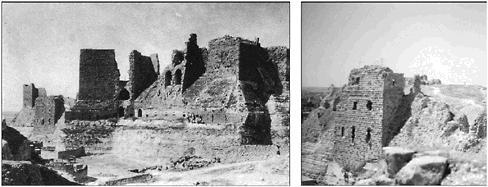Muslim Fortresses in the Levant: Between Crusaders and Mongols (100 page)
Read Muslim Fortresses in the Levant: Between Crusaders and Mongols Online
Authors: Kate Raphael
Tags: #Arts & Photography, #Architecture, #Buildings, #History, #Middle East, #Egypt, #Politics & Social Sciences, #Social Sciences, #Human Geography, #Building Types & Styles, #World, #Medieval, #Humanities

The first fortress along this section of the river that was taken and rebuilt by the Mamluks was al-Bīra. The fortress is situated in the modern Turkish town of Birecik on the east bank of the Euphrates. The name Birecik derives from the Arabic
bīra
with a Turkish diminutive, giving the sense of “little fortress.”
217
This hardly does justice to the site; although it did not occupy much land, it towered high above its surroundings and was a forbidding and impregnable stronghold.
Between 1099 and 1150, al-Bīra officially belonged to the Crusader county of Edessa. Although Edessa fell to Zengi in 1144, he did not manage to conquer al-Bīra. According to Ibn al-Athīr in 577/1178 it was under Mosul’s jurisdiction. The governor of the fortress surrendered to al-Dīn in 578/1179. This was pat of a larger campaign waged by
al-Dīn in 578/1179. This was pat of a larger campaign waged by al-Dīn during that year in the region of the Euphrates.
al-Dīn during that year in the region of the Euphrates.
218
Most of the fortress was probably built by the Ayyubids during the 82 years prior to the Mongol conquest in 1260. However, of the six inscriptions found and recorded by van Berchem, only three are from the citadel and none commemorate the Ayyubid rulers. The earliest inscriptions carries the name of Barka Khan, Baybars’ son and heir.
219
On the eve of the Mongol invasion al-Bīra was held by the Ayyubid ruler of Syria, Yūsuf.
Yūsuf.
220
Hülegü besieged al-Bīra in al-Hijja 657/December 1259. The garrison fought as best as it could but it was vastly outnumbered by the Mongol army. The fortress fell within two weeks.
al-Hijja 657/December 1259. The garrison fought as best as it could but it was vastly outnumbered by the Mongol army. The fortress fell within two weeks.
221
Al-Bīra was re-captured by Aqqush al-Barlī (a Mamluk of Yūsuf’s father) in the winter of 1261. Hülegü sent a message to al-Barlī asking him to submit and offering him al-Bīra as an
Yūsuf’s father) in the winter of 1261. Hülegü sent a message to al-Barlī asking him to submit and offering him al-Bīra as an , al-Barlī refused and decided to submit to Baybars. Al-Bīra came under the Sultan’s rule in 660/1262.
, al-Barlī refused and decided to submit to Baybars. Al-Bīra came under the Sultan’s rule in 660/1262.
222
Although al-Bīra is often mentioned in siege accounts, we have few detailed descriptions of the Mamluk construction work or of the town. Ibn Shaddād, Ibn al-Furāt

Figure 4.32
Al-Bīra, the fortress in the early twentieth century (left) and 2004 (right)
and all give brief accounts. Later reports add some important information. The last Mamluk phase of construction work took place under Qaytbāy (r.872/1468–901/1496), who inspected the fortresses along the Euphrates and personally ordered the repairs of al-Bīra’s fortifications. It seems, however, that Qaytbāy attached more importance to the town’s defenses than to the fortress itself, as attested by three inscriptions along the town’s walls that carry his name.
all give brief accounts. Later reports add some important information. The last Mamluk phase of construction work took place under Qaytbāy (r.872/1468–901/1496), who inspected the fortresses along the Euphrates and personally ordered the repairs of al-Bīra’s fortifications. It seems, however, that Qaytbāy attached more importance to the town’s defenses than to the fortress itself, as attested by three inscriptions along the town’s walls that carry his name.
223
Trying to reconstruct the site of al-Bīra
The fortress of al-Bīra is in an extremely poor state of preservation, and one can only envy Gertrude Bell and Creswell who visited the site in the early twentieth century while it stood in full grandeur (
Figure 4.32
). Much of its stone has been taken and recycled by the local people during the last century.
The northern part and the entire center of the fortress are almost completely in ruins. An outline of the curtain wall along the western side can still be seen, as well as the tower at the southwest corner and the inner mosque. Along the eastern side a tower still stands to the height of three floors, the façade almost complete, though the inner chambers are partly ruined. The passage caved through the rock along the western side is reasonably well preserved, and even though the upper section has collapsed it is still impressive.
In addition to the poor state of conservation our knowledge of the site is hampered by the lack of contemporary Mamluk or Ayyubid texts. A further problem is the lack of a detailed plan.
224
This is surprising, since several of the fortresses along the Euphrates have been surveyed and plans have been drawn or sketched by travelers and/or research teams. The reconstruction of the site, therefore, relies heavily on photographs taken by Creswell, a sketchy plan published in 1996, a study of the site I had made in the summer of 2004, the six Mamluk inscriptions, and the few sources that give an account of the sieges.
The only information attached to Creswell’s photographs, noted that they were taken in the early years of the twentieth century. Thee was no other commentary apart from vague dates and a one word description of the structure that appear in

Figure 4.33
Al-Bīra, aerial photo (1968)
each photograph. If Creswell had taken notes while he was at the site none were published by him.
Since the photographs covered the entire external circumference, it was possible to reconstruct a large part of the fortress.
225
Nevertheless, even though the photographs are of excellent quality some details are missing.
